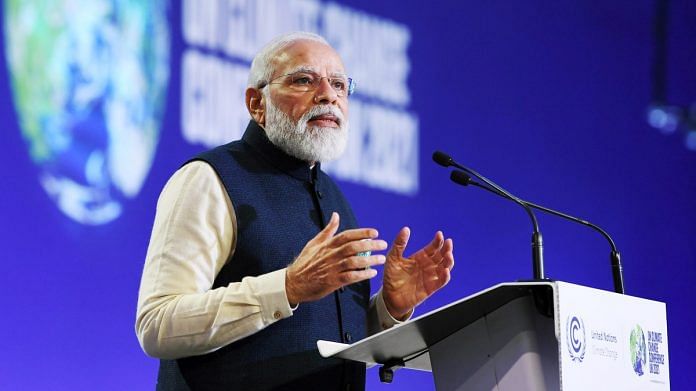Earlier this week, Prime Minister Narendra Modi stood on a global stage to announce climate commitments that surprised the world. Months after seemingly resisting the pressure from high-income countries to “do more” to save the planet, India changed its mind and offered the world more than what it was expecting.
The global stage in question is the 26th Conference of Parties (COP26) taking place in Glasgow right now. Countries have come together to figure out how to slow global warming, and even though these negotiations take place annually, the conference has taken on a new fervour since the Intergovernmental Panel on Climate Change (IPCC) warned that humanity will have already missed the bus, sending the earth down a path of irreversible man-made destruction, unless substantial action takes place now.
A cursory look at headlines coming out of COP26 includes everything from leaders urgently signing pledges to cut back on coal and deforestation to reports calling out high-income countries for making hollow promises. With a renewed urge to stop climate change, world leaders seem to be at least talking the talk. Only time will tell if they will walk the walk. This is why COP26 is ThePrint’s Newsmaker of the Week.
Also Read: India can’t turn into another China. It must protect our ‘mother nature’ from danger
India at the COP
At the podium, Modi made five new promises that experts agree are all ambitious, but could go one way or the other in practice.
In its new pledges, India said it would, by 2030, increase its installed renewable capacity to 500 gigawatts, install 50 per cent of its power capacity through non-fossil fuel resources, reduce carbon emissions by 1 billion tonnes, and reduce the carbon emissions intensity of the economy by 45 per cent.
It also said it would reach net-zero emissions — removing as much carbon dioxide from the atmosphere as is produced — by 2070. For the world’s third-largest emitter (we emitted 2.88 billion tonnes of carbon dioxide last year) this is a lot.
Practically, this means phasing out coal, which fuels 70 per cent of our electricity, switching to electric vehicles, decarbonising polluting industries like cement and steel, creating forests to absorb carbon dioxide, and installing more solar power plants, all in the next few decades.
Our next-door neighbour, China, didn’t make any new commitments despite being the world’s largest carbon emitter today — responsible for 11 per cent of all emissions. The United States, critics have said, should have pledged net-zero emissions much before 2050 to make up for its historical emissions causing global warming today.
It’s in this context that India, a country that only ranks 131 in the Human Development Index, and still has a long way to go when it comes to eliminating widespread poverty, is being praised.
India’s stance, however, wasn’t always this clear. Just a few short months ago, on more than one occasion, it politely declined to pledge net-zero emissions, arguing that countries should instead deliver on the promises they had made in the past. Reports have shown that India is among the few countries on track to deliver on its Paris Agreement targets — the goals set during the 21st COP.
When the IPCC warned that countries must cut emissions and reach net-zero by 2050, India said its stance had been “validated” and that it was on developed countries to make deep cuts.
Joe Biden’s World Leaders Summit, visits by US climate envoy John Kerry and COP President Alok Sharma — all in pursuit of India’s elusive net-zero pledge — were in vain.
Also Read: What is the ‘Global Methane Pledge’ that 103 countries signed at COP26
A history of climate change negotiations
The COP has been going on since 1995, but there are a lot of expectations riding on this meeting in particular.
The COP26 is the first since the Paris Agreement to review and revise climate change targets, which aim to limit global warming to “well below” 2 degrees Celsius. It’s also the first COP which will determine the rules governing the Paris Agreement — those pertaining to climate finance, for example.
Climate finance is a prickly topic. Low and middle-income countries have called out high-income countries for failing to deliver the $100 billion promised back in 2009. This money is to help developing countries mitigate and adapt to climate change, without which they will not only face devastation, but risk not meeting their goals as well.
A report by the UN’s standing committee on finance said that developing countries would actually need trillions of dollars to achieve just a fraction of their climate change targets made in 2015. The IPCC’s report warns that if countries don’t do more to limit climate change, temperatures will soar to 2.7 degrees by the end of the century.
Developed countries have sheepishly admitted that they won’t be able to deliver the $100 billion before 2023. Climate activists have termed their efforts to get private-sector funding “greenwashing” — falsely claiming to protect the environment while companies continue to harm it.
India’s headlining commitments came with another message that shouldn’t be skipped over.
“India expects developed countries to make 1 trillion dollars available as climate finance as soon as possible. Today, as we track the progress on climate mitigation, the same way we must track climate finance,” Modi said, adding, “Justice will truly be served if we put pressure on those countries that have not lived up to their climate finance commitments.”
What he meant was that mitigating climate change is a two-way street. And there is no scope for the developed nations to shrug off their responsibilities.
Views are personal.
(Edited by Srinjoy Dey)



